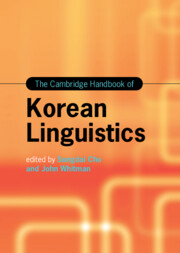Book contents
- The Cambridge Handbook of Korean Linguistics
- Cambridge Handbooks in Language and Linguistics
- The Cambridge Handbook of Korean Linguistics
- Copyright page
- Contents
- Figures
- Tables
- Contributors
- Preface
- Acknowledgments
- Abbreviations
- Part I Korean Overview
- Part II Phonetics and Phonology
- Part III Morphology and Syntax
- Part IV Semantics and Pragmatics
- Chapter 17 Subjectivity and Intersubjectivity in Korean Grammar
- Chapter 18 Discourse Studies in Korean
- Chapter 19 Metaphoric and Metonymic Patterns with the Body-Part Term Nwun “Eye(s)” in Korean
- Chapter 20 Wh-Indefinites
- Chapter 21 “Expletive” Negation in Korean
- Chapter 22 Case Stacking in Korean: Argument Structure or Information Structure?
- Part V Sociolinguistics and Psycholinguistics
- Part VI Language Pedagogy
- Index
- References
Chapter 18 - Discourse Studies in Korean
from Part IV - Semantics and Pragmatics
Published online by Cambridge University Press: 30 September 2022
- The Cambridge Handbook of Korean Linguistics
- Cambridge Handbooks in Language and Linguistics
- The Cambridge Handbook of Korean Linguistics
- Copyright page
- Contents
- Figures
- Tables
- Contributors
- Preface
- Acknowledgments
- Abbreviations
- Part I Korean Overview
- Part II Phonetics and Phonology
- Part III Morphology and Syntax
- Part IV Semantics and Pragmatics
- Chapter 17 Subjectivity and Intersubjectivity in Korean Grammar
- Chapter 18 Discourse Studies in Korean
- Chapter 19 Metaphoric and Metonymic Patterns with the Body-Part Term Nwun “Eye(s)” in Korean
- Chapter 20 Wh-Indefinites
- Chapter 21 “Expletive” Negation in Korean
- Chapter 22 Case Stacking in Korean: Argument Structure or Information Structure?
- Part V Sociolinguistics and Psycholinguistics
- Part VI Language Pedagogy
- Index
- References
Summary
Chapter 18 surveys research over the last few decades on discourse analysis in Korean linguistics. Since the 1980s, a number of Korean linguists have explored the relationship between discourse and grammar, dealing with topics such as information flow, choice of NPs in discourse, word order variability, case markers, pragmatic functions of clausal connectives and sentence-enders, grammaticalization, cohesion and coherence, and text structures. In the 1990s and 2000s, discourse analysts have explored the relationship between conversation, social action, and grammar, introducing the assumptions and methodology of conversational analysis into discourse analysis. The chapter provides a brief overview of major findings and research topics in analyses of conversational data in Korean linguistics in terms of (i) turn-taking, turn-constructional units, and turn increments, (ii) interactional functions of some clausal connectives and sentence-ending suffixes, and (iii) other interaction-based studies of topics such as repair, demonstratives, and reported speech. It also discusses discourse studies carried out from the perspectives of sociolinguistics and Critical Discourse Analysis (CDA).
Keywords
- Type
- Chapter
- Information
- The Cambridge Handbook of Korean Linguistics , pp. 524 - 553Publisher: Cambridge University PressPrint publication year: 2022



